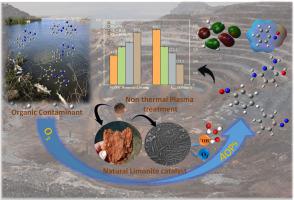Journal of Hazardous Materials ( IF 12.2 ) Pub Date : 2021-01-07 , DOI: 10.1016/j.jhazmat.2021.125074 Rasool Pelalak , Zahra Heidari , Reza Alizadeh , Eslam Ghareshabani , Negin Nasseh , Azam Marjani , Ahmad B. Albadarin , Saeed Shirazian

|
High-performance novel iron oxyhydroxide (limonite) nanostructure, with improved surface reactive sites, was prepared via one-pot, eco-friendly, free precursor and cold glow discharge N2-plasma technique. Natural and plasma treated (PTNL/N2) limonite samples were characterized by FESEM, XPS, XRD, FTIR, AAS, EDX, BET/BJH and pHpzc to confirm the successful synthesis. Central composite design (CCD) and artificial neural network (ANN, topology of 4:8:1) methods were utilized to study the oxidation/mineralization of phenazopyridine (PhP) as a hazardous contaminant by heterogeneous catalytic ozonation process (HCOP). The obtained results indicated that PTNL/N2 had the highest catalytic performance in PhP degradation (98.6% in 40 min) and mineralization (80.4% in 120 min). The degradation mechanism in different processes was investigated by dissolved ozone concentration, various organic scavengers (BQ and TBA) and inorganic salts (NaNO3, NaCl, Na2CO3 and NaH2PO4). Moreover, reusability-stability, Fe and nitrogen (NO3− and NH4+) ions release were assessed during different AOPs. Furthermore, toxicity tests indicated that the HCOP using PTNL/N2 was able to detoxify the PhP solutions efficiently. Finally, Density Functional Theory (DFT) studies were employed to introduce the most plausible contaminant degradation pathway, reactive sites and byproducts. This research provided a new insight into the improvement of wastewater treatment studies by a combination of experiment and computer simulation.
中文翻译:

使用通过等离子体技术制备的新型羟基氧化铁(III)高效氧化/矿化药物污染物:实验,建模和DFT研究
通过一锅法,生态友好型,游离前体和冷辉光放电N 2等离子体技术制备了具有改善的表面反应位的高性能新型羟基氧化铁(褐铁矿)纳米结构。通过FESEM,XPS,XRD,FTIR,AAS,EDX,BET / BJH和pH pzc对天然和血浆处理的(PTNL / N 2)褐铁矿样品进行表征,以确认合成成功。利用中央复合设计(CCD)和人工神经网络(ANN,拓扑结构为4:8:1)方法研究了通过异质催化臭氧化工艺(HCOP)将作为危险污染物的苯并吡啶(PhP)的氧化/矿化作用。所得结果表明PTNL / N 2在PhP降解(40分钟内为98.6%)和矿化(120分钟内为80.4%)方面具有最高的催化性能。通过溶解臭氧浓度,各种有机清除剂(BQ和TBA)和无机盐(NaNO 3,NaCl,Na 2 CO 3和NaH 2 PO 4)研究了不同过程中的降解机理。此外,可重用性稳定性,Fe和氮(NO 3 -和NH 4 +)离子的释放分别在不同的AOP评估。此外,毒性测试表明使用PTNL / N 2的HCOP能够有效地排毒PhP解决方案。最后,采用密度泛函理论(DFT)研究来介绍最合理的污染物降解途径,反应位点和副产物。这项研究通过实验和计算机模拟相结合,为改进废水处理研究提供了新的见识。











































 京公网安备 11010802027423号
京公网安备 11010802027423号